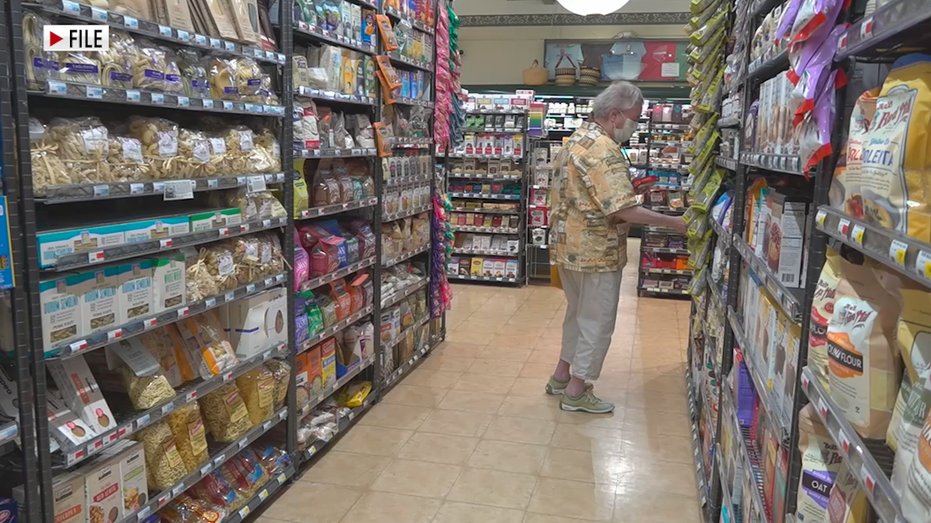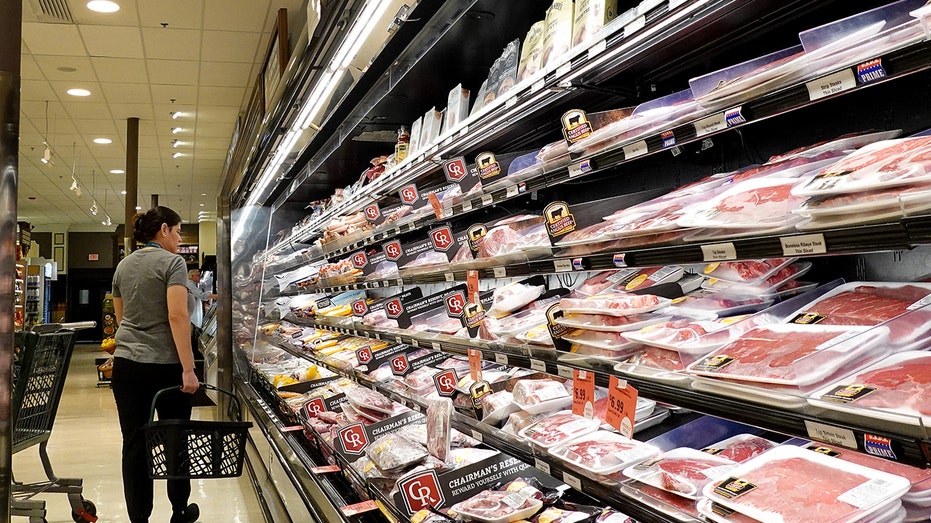Delayed IRS returns, consumers provide inflation expectations and more: Tuesday's 5 things to know
The Bureau of Labor Statics will release its consumer price index report on Tuesday
FOX Business Flash top headlines for September 12
Check out what's clicking on FoxBusiness.com
Here are five key things that could impact Tuesday's trading.
IRS PLAYING CATCHUP: The Internal Revenue Service is sending refunds to more than a million Americans who filed their taxes late in the early days of the COVID-19 pandemic – but time is running out for taxpayers to collect the money.
Nearly 1.6 million filers will automatically receive refunds or credits worth a collective $1.2 billion – an average of $750 per person.
There are just a few weeks left to qualify for the relief. In order to receive the money, Americans need to file their individual tax returns by Sept. 30, 2022.
INFLATION NOW CAUSING FINANCIAL PAIN FOR MOST AMERICANS, SURVEY SHOWS

The Internal Revenue Service (IRS) headquarters in Washington, D.C., on Friday, Feb. 25, 2022. (Al Drago/Bloomberg via Getty Images / Getty Images)
Typically, the IRS charges individuals who file returns late without an extension a failure-to-file penalty – an extra 5% per month on the unpaid amount, which can add up to 25% of the tax due. But the tax-collecting agency is waiving that fee for many individuals and businesses who filed returns for 2019 and 2020 late.
"The penalty relief issued today is yet another way the agency is supporting people during this unprecedented time," IRS Commissioner Chuck Rettig said in a statement last month. "This penalty relief will be automatic for people or businesses who qualify; there's no need to call."
Eligible tax returns include individual, corporate, estates and trusts, the IRS said. People who have been fined but who have not yet paid the penalty will see it eliminated, while individuals who already paid the late-file fee will get a refund or credit.
A majority of the refunds will be issued by the end of September, the agency said.
The announcement comes as the IRS continues to wade its way through a backlog of unprocessed tax returns. As of Aug. 12, the IRS still had 9.3 million unprocessed individual tax returns from 2022, including about 7.6 million paper returns.
The heap of unprocessed returns stemmed from pandemic-related disruptions, including a worker shortage, the herculean task of administering millions of stimulus checks, and adapting to other tax changes in the different COVID-19 relief packages, like boosted child tax credit payments.
INFLATION EXPECTATIONS DROP AGAIN: Consumer expectations for where inflation will be one year from now fell again in August, according to a key Federal Reserve Bank of New York survey published Monday, a potentially reassuring sign for the U.S. central bank as it tries to cool surging prices.
The median expectation is that the inflation rate will be up 5.7% one year from now, a marked decline from 6.2% recorded in June, according to the New York Federal Reserve's Survey of Consumer Expectations. Three years from now, consumers see inflation cooling off slightly to 2.8% – down from the 3.2% recorded last month.
Consumers anticipate that prices will drop even further over the next five years, projecting that the inflation rate will hover around 2% in 2027.
"Median inflation uncertainty – or the uncertainty expressed regarding future inflation outcomes – decreased at the short-term horizon and was unchanged at the medium-term horizon," the survey said.
INFLATION NOW CAUSING FINANCIAL PAIN FOR MOST AMERICANS, SURVEY SHOWS

The price of food is soaring amid inflation. (Fox News)
The report is based on a rotating panel of 1,300 households.
The survey plays a critical role in determining how Fed policymakers respond to the inflation crisis. That is because actual inflation depends, at least in part, on what consumers think it will be. It is sort of a self-fulfilling prophecy – if everyone expects prices to rise by 3% in the year, that signals to businesses that they can increase prices by at least 3%. Workers, in turn, will want a 3% pay raise to offset the rising costs.
A steeper-than-expected increase in inflation expectations in May actually prompted Fed officials to approve the first 75-basis-point interest rate hike since 1994 on fears that higher prices were becoming entrenched.
In explaining the Fed's decision during a post-meeting press conference, Chairman Jerome Powell said policymakers were looking for evidence that monthly inflation was flattening or starting to fall. With consumer prices repeatedly surprising to the upside and inflation expectations unexpectedly climbing higher, officials determined that "strong action was warranted," he said.
"One of the factors in our deciding to move ahead with 75 basis points today was what we saw in inflation expectations," Powell told reporters during a press conference after the meeting. "We're absolutely determined to keep them anchored at 2%. That was one of the reasons – the other was just the CPI reading."
CPI REPORT DUE: At 8:30 a.m. ET, the Bureau of Labor Statistics is expected to say the consumer price index fell 0.1% month-over-month in August, after being unchanged in July.
On a year-over-year basis expect prices to climb 8.1% in August, easing back from July’s cooler-than-expected reading of 8.5% (the estimate was 8.7%) and June’s 9.1% surge, the highest inflation rate in almost 41 years (since November 1981).

The Bureau of Labor Statistics is expected to release August consumer price index figures on Tuesday, September 13, 2022. The figures are expected to show the consumer price index fell 0.1% month-over-month in August, after being unchanged in July. (Joe Raedle/Getty Images / Getty Images)
A cooler pace of CPI growth, together with the smaller-than-expected increases in the July PCE indices out three weeks ago, would reinforce the view that inflation has peaked.
Factoring out volatile food and energy costs, the core consumer price index is anticipated to rise 0.3% in August, matching July’s increase.
Annually, core CPI is forecast to climb 6.1% in August. That would snap a 4-month streak of flat or slowing growth after March’s 6.5% spike, the highest in almost 40 years (since August 1982).
US MARKETS MOVE HIGHER: U.S. stocks rose Monday, ahead of key inflation data that is expected to show further cooling of consumer prices.
The S&P 500 gained 43.05 points, or 1.1%, to 4110.41 after it closed higher for the week on Friday. The Dow Jones Industrial Average added 229.63, or 0.7%, to 32381.34. The technology-heavy Nasdaq Composite climbed 154.10, or 1.3%, to 12266.41.
All three indexes logged their fourth consecutive trading day of advances. Indexes have charted a steady rise in recent sessions as concerns about large interest-rate hikes have been alleviated. Tumbling commodity prices have lifted hopes that the worst of inflation has passed.
Meanwhile, the labor market has remained a key source of economic strength. Gauges of business activity have been stronger than expected.
| Ticker | Security | Last | Change | Change % |
|---|---|---|---|---|
| I:DJI | DOW JONES AVERAGES | 44782 | -128.65 | -0.29% |
| SP500 | S&P 500 | 6047.15 | +14.77 | +0.24% |
| I:COMP | NASDAQ COMPOSITE INDEX | 19403.947849 | +185.78 | +0.97% |
"The biggest thing driving markets now is investor optimism that inflation is falling," said Michael Arone, chief investment strategist for the U.S. ETF business at State Street Global Advisors. "We're in that period where earnings season is over, and it does become all about the biggest story of the year: the Fed and what is the end-target federal funds rate."
U.S. consumer-price inflation data will help Federal Reserve officials gauge how far their fight against soaring prices has come and how much further they might need to lift interest rates. Fed officials have an interest-rate meeting next week.
"If inflation moderates quicker than expected, I think the Fed can get more comfortable that their job might be closer to being done than they originally thought," said Stephanie Lang, chief investment officer at Homrich Berg.
Inflation has likely peaked, she added, but markets are unlikely to push much higher until the Fed begins to moderate its tightening campaign.
"What the market is pricing in right now is a soft landing, which I think is pretty optimistic," she said.
Despite some signs of inflation decelerating, investors largely expect Fed officials to continue tightening for some months to be sure price pressures have abated. Many investors expect the Fed to raise interest rates by another 0.75 percentage point next week.
STOCKS IN THE NEWS: Bristol-Myers Squibb jumped $2.20, or 3.1%, to $72.36 after the U.S. Food and Drug Administration approved the drugmaker's psoriasis treatment, Sotyktu.
Gilead Sciences gained $2.73, or 4.2%, to $68.01 after the company said it settled a patent case related to its HIV therapies.
| Ticker | Security | Last | Change | Change % |
|---|---|---|---|---|
| BMY | BRISTOL MYERS SQUIBB CO. | 59.22 | -0.05 | -0.08% |
| GILD | GILEAD SCIENCES INC. | 92.58 | +0.17 | +0.18% |
| TWTR | NO DATA AVAILABLE | - | - | - |
Meanwhile, Twitter fell 78 cents, or 1.8%, to $41.41 after the company's lawyers said Twitter intends to enforce its purchase agreement with Elon Musk.
CLICK HERE TO READ MORE ON FOX BUSINESS
Musk's legal team on Friday cited a whistleblower payment as a new reason to drop the takeover.
